University Heights Historical Society
Membership is available at an individual or family level for a one time membership fee. The benefits of membership are:
-
- A history of University Heights in book form
- Walking Tour of UH
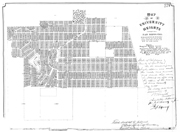 The history of University Heights begins during San Diego’s first period of large–scale urbanization. After completion of the Santa Fe transcontinental railroad in 1885, San Diego’s population increased by approximately 2,000 new residents each month.
The history of University Heights begins during San Diego’s first period of large–scale urbanization. After completion of the Santa Fe transcontinental railroad in 1885, San Diego’s population increased by approximately 2,000 new residents each month.Several speculative real estate developments were initiated to accommodate the increased demand for housing — one of them was University Heights. In 1887, a large windswept tract of land overlooking Mission Valley was subdivided by the College Hill Land Association, a syndicate of businessmen owning land in the proposed subdivision.
Headed by Daniel Choate, who was also developing City Heights to the southeast, the syndicate promised prospective buyers that a branch college of what would eventually become the University of Southern California would be located in University Heights. The proposed San Diego College of Arts was to be the drawing point of the subdivision.
On August 6,1888, Subdivision map #558 was filed with the San Diego County Recorder, delineating the University Heights subdivision. Trapezoidal in shape, the subdivision stretched along the south rim of Mission Valley, from the present-day boundary of Freeway 163 on the west, to the divisional boundary between city pueblo land and ex-Mission San Diego land (today’s Boundary Street). The southern boundary was along Fillmore Avenue (today’s University Avenue).
According to literature published by the syndicate, an endowment fund of $2 million would be created to help establish the college. Part of the cost of each lot sold in the subdivision would go into a college building fund, guaranteeing the development and maintenance of the college.
However, construction of the college never advanced beyond the planning stage, as the real estate boom suddenly burst in 1889. Prospective buyers figured out that, besides sunshine and land, San Diego had no other readily marketable commodities to exploit. There was no oil, coal, lumber, or most importantly, an adequate supply of potable water.
The Grand State Normal School Built in University Heights
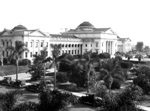 A second attempt to bring an institution of higher learning to the area was initiated in 1898. The site of the aborted San Diego College of the Arts was donated to the State of California to build a “Normal School,” a state-sponsored teacher-training college.
A second attempt to bring an institution of higher learning to the area was initiated in 1898. The site of the aborted San Diego College of the Arts was donated to the State of California to build a “Normal School,” a state-sponsored teacher-training college.A Neoclassic Revival college building, designed by local architects William S. Hebbard and Irving Gill, was completed and opened in 1899. The State Normal School was the forerunner of the present San Diego State University.
The Normal School operated in this location for over thirty years. In 1925, the Normal School was granted college status and, in 1931, was relocated to its present site on Montezuma Mesa. The old Normal School was converted into Horace Mann Junior High School but was demolished in the 1950s to make way for a parking lot at the Education Center between Campus Avenue and Normal Street.
Cable Cars Come to University Heights
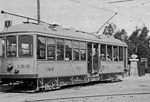 Although some distance from downtown San Diego, University Heights was an early “streetcar suburb,” a residential area whose development was closely tied to direct access to downtown San Diego’s commercial and business center by cable, then electric-powered, trolleys.
Although some distance from downtown San Diego, University Heights was an early “streetcar suburb,” a residential area whose development was closely tied to direct access to downtown San Diego’s commercial and business center by cable, then electric-powered, trolleys.Just like the more famous San Francisco cable cars, the San Diego Cable Railway traveled south along Fourth Street through University Heights all the way to L Street in downtown San Diego. Here, connections could be made with several steam-powered interurban railroads and the Coronado Ferry. A steam-powered powerhouse and car barn was located at Fourth and Spruce.
The cable railway’s tracks entered University Heights at Fourth Street and Fillmore Avenue (today’s corner of Fourth and University in Hillcrest), where it traveled eastward until jogging northeast along University Boulevard (today’s Normal Street) to Carolina Street (today’s Park Boulevard).
The Bluffs Attracts Visitors to University Heights
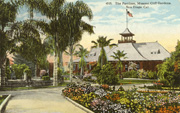 At the end of North Avenue, the northern-most terminus of the cable car line, the San Diego Cable Railway developed a five-acre park with an attractive pavilion designed by prominent local architect William S. Hebbard. The park, known as The Bluffs, was developed by the railway company to attract passengers to the sparsely populated area.
At the end of North Avenue, the northern-most terminus of the cable car line, the San Diego Cable Railway developed a five-acre park with an attractive pavilion designed by prominent local architect William S. Hebbard. The park, known as The Bluffs, was developed by the railway company to attract passengers to the sparsely populated area.However, due to a series of financial setbacks, the cable railway was forced to shut down after just thirteen months of operation. It fell into receivership until 1895, when it was bought by George B. Kerper. Kerper reorganized the company into the Citizens Traction Company, and electrified the line.
Kerper restored The Bluffs and renamed it Mission Cliff Park. With a merry-go-round, a playground, and a shooting gallery, the park became the place to go on Sunday afternoons. Dancing parties were held in the pavilion, where Japanese lanterns hung from the rafters. The first outdoor San Diego production of William Shakespeare’s As You Like It was performed at the park in 1897. Theatrical and vaudeville companies also performed here. And, despite much opposition from the San Diego City Council, a liquor license was granted and a German Beer Garden was opened.
Kerper also proposed to construct a cog railway down to the canyon floor below the park, where it would connect with an electric-powered trolley to take sightseers to the ruins of Mission San Diego de Alcala. However, his dreams never materialized because in 1898, during the height of a nationwide depression, Kerper’s company went into receivership.
The only prospective purchaser was John and Adolph Spreckels’ San Diego Electric Railway Company. In 1898, the Citizens Traction Company was sold to E.S. Babcock, as acting agent for the Spreckels’ interests. The San Diego Electric Railway Company kept five trolleys and widened the right-of- way from Fifth Street and University Avenue, where it was connected to an already existing Spreckels-owned trolley line, up to the park.
Mission Cliff Gardens: Jewel of University Heights
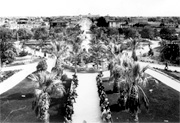 After its purchase by the San Diego Electric Railway Company in 1898, the park was again renovated and renamed Mission Cliff Gardens. John D. Spreckels wished to showcase the area as a botanical garden rather than an amusement park.
After its purchase by the San Diego Electric Railway Company in 1898, the park was again renovated and renamed Mission Cliff Gardens. John D. Spreckels wished to showcase the area as a botanical garden rather than an amusement park.Spreckels proceeded to have the Camera Obscura removed, as well as the other attractions, and to concentrate on the pavilion and the grounds, which encompassed some 20 acres. In 1904, Spreckels chose Scottish-born landscape gardener John Davidson as the park’s superintendent and asked him to redesign the park into a botanical wonder.
Davidson found that the soil beneath the park left much to be desired, consisting of hard adobe clay and scores of cobblestones. Undaunted, he proceeded to incorporate the cobblestones into the park’s landscape. He and his workers used them to line pathways, tier terraced gardens, and as a construction material for a series of walls throughout the park.
Two of these walls still survive–one surrounds the former lily pond at North Court and Mission Cliff Drive and the other is the impressive cobblestone wall along the north side of Adams Avenue from Park Boulevard to Mission Cliff Drive.
Ostrich Feathers in University Heights
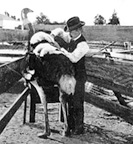 Also in 1904, John D. Spreckels invited Harvey Bentley to relocate his ostrich farm from Coronado.
Also in 1904, John D. Spreckels invited Harvey Bentley to relocate his ostrich farm from Coronado.For an additional fee, visitors to the gardens could gaze upon a dozen or more ostriches around the farm. Fearless visitors could even ride the huge birds. Ostrich feathers were in great demand at the time for ladies hats, boas, and stoles and sold for $350 a pound.
Across the street from the Ostrich Farm was William Hilton’s San Diego Silk Mill (l735 Adams Avenue). Silk production was a thriving industry by the turn of the century. The Chamber of Commerce helped to establish a unique cottage industry in San Diego. Housewives would raise silk worms in their back yards, similar to the Chinchilla craze of the late 1960s.
New Water Supply Spurs Growth
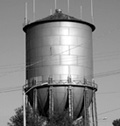 University Heights did not really start to develop until 1907, when the San Diego Electric Railway was extended east on Adams Avenue. Prior to 1907, the trolley line ended at the Trolley Barn at Park and Florida.
University Heights did not really start to develop until 1907, when the San Diego Electric Railway was extended east on Adams Avenue. Prior to 1907, the trolley line ended at the Trolley Barn at Park and Florida.Also during this time, a lawsuit finally ended between Spreckels and one of his ex-partners, Elisha Babcock. The dispute was over the ownership and operation of the Southern California Mountain and Water Supply Company, which they had developed in the 1890s. The suit was settled in favor of Spreckels, who then supplied the city of San Diego with water.
Assured of an abundant supply of water, the city experienced a $6 million increase in new construction and improvements, including a major building program along Broadway in downtown San Diego. All of this building and commercial activity brought investors and new residents into the area. By 1907, San Diego’s population had gone from 17,000 to over 32,000.
New Trolley Line Brings Development to University Heights
Anticipating the potential for growth fueled by the extension of the trolley line, the University Heights Syndicate (George Hawley, president; D.C. Collier, vice president; and Carl O. Reinbold, secretary) formed in 1902 to reorganize the development of University Heights.
The Syndicate planned to develop housing along the new trolley line on Adams Avenue east of Mission Cliff Gardens, as well as on a large tract of unincorporated land to the east to be called Normal Heights. The company’s first subdivision along the new trolley line extension was Valle Vista Terrace, a tract of luxury homes on Panorama Drive which provided magnificent views of Mission Valley and glimpses of the ocean. Both Hawley’s and Reinbold’s homes can be found on Panorama Drive.
In addition to the flurry of building activity after 1906, another water-related event occurred in 1912, which produced still another building boom, including a number of the large apartment blocks in University Heights. At this time, the city purchased most of the reservoirs and water distribution system of the Southern California Mountain Water Company from Spreckels. This gave the city a municipally-owned and operated water supply system “from mountain to meter.”
As a result of this profit windfall, Spreckels invested in a much larger-scaled building program downtown, which further stimulated local growth. By 1913, over $10 million worth of building and improvements were underway in the city.
The Adams Avenue Trolley Barn
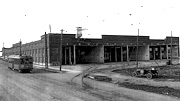 In 1913, a massive trolley car barn was built on property adjoining the ostrich farm. The cavernous reinforced brick building was used to store and perform minor service to several hundred trolleys. Trolleys would exit and enter it through a series of switches off of Florida Street.
In 1913, a massive trolley car barn was built on property adjoining the ostrich farm. The cavernous reinforced brick building was used to store and perform minor service to several hundred trolleys. Trolleys would exit and enter it through a series of switches off of Florida Street.After the trolleys ceased running in 1949, the car barn was sold to the San Diego Paper Box Company, which manufactured corrugated cardboard boxes. Inside the old car barn were found 70 abandoned brand new trolley cars with their upholstery still unused. In 1979, the building was sold and demolished to make way for a condominium project.
However, the land remained undeveloped until l991 when, through community efforts, the area was transformed into the present 8 1/2-acre Trolley Barn Park.
Panama-California International Exposition Brings Many to San Diego
To advertise San Diego’s remarkable growth and its potential for investment as the first West Coast port of call for the almost completed Panama Canal, G. Aubrey Davidson, president of the San Diego Chamber of Commerce, proposed an exposition in Balboa Park. In 1910, the Panama-California Exposition Company was incorporated with D.C. Collier as its general director, and Davidson and Spreckels on the board of directors.
After the announcement of the proposed Exposition, San Diego experienced a large-scale increase in home, hotel, and apartment construction. A number of structures in University Heights were built during that time. These developments are especially pronounced at the intersection of Adams Avenue and Park Boulevard. Here, passengers would transfer from the #1 trolley line on Park Boulevard to the Adams Avenue shuttle trolley line. Installed in 1907, the Adams Avenue shuttle finally provided through service from Kensington Park to downtown San Diego.
Popularity of Mission Cliff Gardens Declines
Due to the popularity of Balboa Park after the 1915 Panama-California International Exposition, and the development of Mission Beach by Spreckels in the 1920s, the popularity of Mission Cliff Gardens declined. The final blow was the death of Spreckels in 1926. Mission Cliff Gardens was closed in 1930 and relegated as a “Physical Non-Operating Property.”
Davidson was allowed to live in the Pavilion, but as the electric railway company cut down on water expenses, most of the flowers and small plants died. The only plants remaining now are the tall Canary Island Palms north of the intersection of Park and Adams.
After Davidson’s death in 1935, the gardens deteriorated. In 1942, the property was developed by the Spreckels interests to provide critically needed wartime housing. Parts of the cobblestone wall were breached at either end to facilitate automobile traffic.
Preservation Efforts in University Heights
Several vestiges of Mission Cliff Gardens survive and have been historically designated through the efforts of the University Heights Historical Society, including:
The former entrance to Mission Cliff Gardens on Adams Avenue at the end of North Avenue, including the redwood gate, and some of the palm trees.
The cobblestone wall that lined Adams Avenue from Park Boulevard to its dead end.
The cobblestone wall surrounding the former lily pond on Mission Cliff Drive at North Court, built by John Davidson and his workers. The former pavilion designed by William Hebbard stood just north of the pond.
The former entrance to the Ostrich Farm at Park and Adams, including the redwood gate and the cobblestone piers.
The cobblestone remains of a drinking fountain, which was once part of an ornate waiting station for the Number 11 trolley.
In addition to the properties landmarked by the University Heights Historical Society, many private property owners in University Heights have succeeded in having their homes historically-designated. This not only provides them with the opportunity for significant property tax benefits but preserves just a little bit of our history for generations to come.
The cobblestone wall that lined Adams Avenue from Park Boulevard to its dead end.
The cobblestone wall surrounding the former lily pond on Mission Cliff Drive at North Court, built by John Davidson and his workers. The former pavilion designed by William Hebbard stood just north of the pond.
The former entrance to the Ostrich Farm at Park and Adams, including the redwood gate and the cobblestone piers.
The cobblestone remains of a drinking fountain, which was once part of an ornate waiting station for the Number 11 trolley.
In addition to the properties landmarked by the University Heights Historical Society, many private property owners in University Heights have succeeded in having their homes historically-designated. This not only provides them with the opportunity for significant property tax benefits but preserves just a little bit of our history for generations to come.
For More Information
If you would like to support the efforts of the University Heights Historical Society or would like more information about our fascinating history, please click here.
Copyright 2008 University Heights Community Development Corporation
P.O. Box 3115 • San Diego, CA 92163 • (619) 297-3166
P.O. Box 3115 • San Diego, CA 92163 • (619) 297-3166
